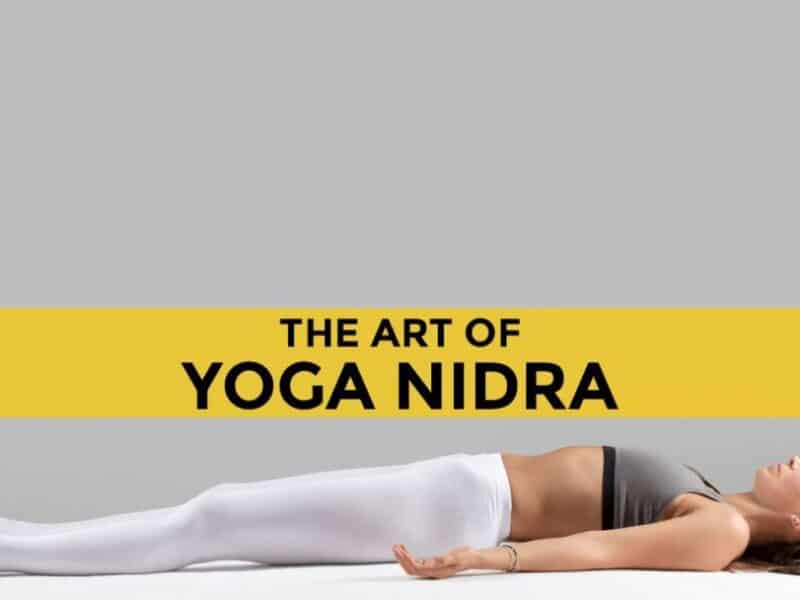
The Art of Yoga Nidra
Today, we will unravel “The Art of Yoga Nidra”. We will understand the practice, how it is performed, and then its benefits.
So, first and foremost, let us clarify what Yoga Nidra is all about. Yoga Nidra, commonly referred to as “yogic sleep,” is a type of consciousness in which the body is in a deep state of relaxation and the mind is at its most alert. The practice has a long history, and its roots are in the yogic traditions of the past.
Through the practice of yoga nidra, we can gain access to the subconscious mind, which houses our thoughts, feelings, and beliefs. It also enables us to change unhealthy patterns into healthy ones, leading to a happier life.
Isn’t that fascinating? Now, let me tell you all a bit about the history of yoga nidra.
History of Yoga Nidra
The history of yoga nidra can be traced back to the early yogic traditions. Since ancient times, yogis have been practicing yoga, which was first mentioned in the Vedas, ancient Hindu literature. The practice became well-known in the West around the middle of the 20th century thanks to the contributions of Swami Satyananda Saraswati, who is recognized as the creator of modern yoga nidra. In order to assist practitioners in achieving a state of profound relaxation and increased awareness, he developed a method of yoga nidra that integrates a number of practices, such as relaxation, visualization, and meditation.
That’s really interesting, right? Now, after knowing about the history of yoga nidra, and what it is all about, it’s time to understand the practice of yoga nidra. How exactly it is performed, and what is the process to gain the benefits?
Principles and Practice of Yoga Nidra
Yoga nidra’s fundamental goal is to help practitioners become conscious of their entire physical personality, or annamaya kosha, which can be done by simply relaxing every bodily organ and biological process while letting go of one’s joyous awareness. The part of one’s mind that includes all breathing processes (pranamaya kosha) and nerve centers (chakra), as a result, experiences serenity and clarity. The mind is positively influenced by realizing one’s true, natural, and peaceful annamaya and pranamaya koshas, which causes traces of ignorance, rage, and worry to disappear. One’s true potential is realized as a result of this beneficial impact on the mind and all mental formations (manomaya kosha). One might logically progress to finer and higher levels of spirituality to achieve inner happiness and peace. This is unquestionably what every motivated practitioner aspires to in the end.
The stages of the Yoga Nidra practice are initially somewhat deliberate but with practice they become more automatic and natural. These include getting ready for the practice, presenting oneself with a personal resolution or commitment to later action (Sankalpa), then focusing awareness on various body parts, breathing, remembering various feelings and sensations, mental visualization, restating the personal resolution or Sankalpa, and concluding the practice session.
Come on, let’s understand the first stage that is Preparation
Stage 1: Preparation
Before initiating the mental steps that are required to enter into the conscious sleep state of yoga nidra, the practitioner adopts the classic Savasana or “corpse pose”.
This position, which is among the most crucial in yoga practice, involves turning the palms upward and avoiding making contact with the body’s limbs. This reduces the sensation of touch and is recognized as a vital step in the process of calming the body and bringing about mental tranquility. Moreover, practitioners must keep from moving in any way, stay awake, and pay attention to all directions given. The practitioner inhales deeply while spreading his arms and legs out to roughly 45 degrees while lying supine with his eyes closed.
After you have prepared yourself for the practice, the second stage includes taking a Sankalpa
Stage 2: Taking a Sankalpa
The next step in the yoga nidra technique is for the practitioner to mentally state to himself a personal objective, or “Sankalpa,” which should be succinct, unambiguous, and encouraging (i.e., usually dedicated to some goal of self-realization or improvement). The objective could be quite lofty or as simple as quitting a bad habit, as in “I resolve to stop smoking.” The chosen Sankalpa should be mentally repeated three times by the practitioner with unwavering focus. Passivity is what yoga nidra gurus refer to as the condition of mental separation that this resolution results in. The self is separated from the experiences that would typically be emotionally upsetting in this passive condition. The auto-suggested answer is more easily assimilated into the unconscious under these circumstances.
Stage 3: Rotation of Consciousness
The third level involves a methodical and controlled shifting of the practitioner’s mental visualization between various body areas. Starting with the right side of the body, the practitioner directs awareness first at the thumb on the right hand before moving on to the little toe on the right foot. Next, the practitioner directs awareness to the left side of the body, repeating the sequence from the digits on the left hand to the digits on the left foot. Finally, the practitioner repeats the sequence from the heels to the back of the head. It has been proposed that this entire practice may function as an efficient technique for developing pertinent motor skills on its own. As the learner of yoga nidra progresses to later and deeper stages of practice, this further increases the usefulness of the process.
So, you might be wondering what the next step holds.
Stage 4: Breath Awareness
Many strategies are used simultaneously in the breath awareness stage to allow the practitioner to concentrate on the normal breathing process without seeking to alter it in any way. The ability to visualize is crucial to mastering this. The person practicing yoga nidra is told to picture the breath coming and going from the nose, the chest, the abdomen, and between the navel and the throat. He/She is also instructed to mentally count each inhalation and exhalation.
Stage 5: Opposite feelings and sensations
In order to make the most effective possible, the person is urged to recollect physical or emotional experiences and the sensations that went along with them with heightened vividness. Experiencing opposing emotions or sensations, such as weight and lightness, heat and cold, pain and pleasure, and so on, are a few examples of this process.
And then comes the best part of the whole yoga nidra process which is Visualization
Stage 6: Visualization
The following step of practice once again places visualization at the center of the process. The student is told to focus consciousness on the area known as Chidakasha in yogic terminology, which is the black area in front of closed eyes (internally visualized as being centered just behind the forehead). The next step is to invite the yoga nidra user to picture different scenarios or circumstances in the Chidakasha.
Stage 7: Taking a Sankalpa again
The person again mentally repeats the Sankalpa three times “with full dedication, faith, and optimism,” as it was described in stage two.
How to End the Yoga Nidra Practice Session?
Just before the yoga nidra session ends, the mind slowly shifts its attention to outside noises, things, and people. The practitioner gradually awakens to his body and surroundings, turns to his right side, but continues to lay still for a short while longer. The body is stretched while each body part is carefully manipulated. The practitioner carefully sits up and opens his eyes as soon as it seems comfortable.
This is how a yoga nidra session goes on.
The distinction between Yoga Nidra and other altered states of consciousness
Yoga nidra practitioners claim that while it sometimes resembles sleep or a dream state, it is actually neither of these things. The technique is said to be more similar to the altered state known as Samadhi in yoga (the ultimate “deathless” or “breathless” condition), but it differs in that it is considerably simpler to accomplish. Perhaps it would be more accurate to view yoga nidra as an important stop along the way to Samadhi. In his well-known autobiography, Paramahansa Yogananda eloquently portrayed the accompanying perceptual experiences of yoga nidra.
“During the practice session, if one falls into Samadhi, the walls of the room will actually shimmer and disappear, and then sequentially the walls of the house, and all other remaining points of material reference.”
Parmahansa Yogananda
Health Benefits of Yoga Nidra

Well, now let’s understand what the health benefits are that you can get after performing Yoga Nidra. Yoga nidra lowers stress and anxiety, boosts general well-being, and improves the quality of sleep. The exercise can also aid in the release of unfavorable patterns and the development of advantageous ones, resulting in a more contented life. Yoga nidra has also been used to treat addiction, PTSD (post traumatic stress disorder), and other mental health issues.
How Yoga Nidra helps reduce stress and anxiety?
Hence, while we’re in a profound state of relaxation, our bodies’ stress response mechanism is turned off. It results in lower amounts of stress chemicals like cortisol and adrenaline, which can help reduce levels of tension and anxiety. We may also recognize and let go of any unfavorable thought patterns or ideas that might be causing our stress and worry by getting access to our subconscious minds. This can enhance our general well-being and help us adopt a more optimistic attitude toward life.
Insightful! Isn’t it? Not only that, but yoga nidra also has a spiritual aspect.
The ancient yogic philosophy, which emphasizes the harmony of the mind, body, and spirit, has a strong influence on the practice of yoga nidra. We can get in touch with our actual selves and feel a sense of oneness with the universe by accessing the subconscious mind and letting go of unhelpful tendencies. Many practitioners report having a very spiritual experience during this.
My take to someone who is new to Yoga Nidra
My suggestion is to be patient with yourself and approach the exercise with an open mind. Yoga nidra is a potent technique, but it requires to practise to become proficient. Work your way up to longer sessions by beginning with shorter ones. Most importantly, don’t criticize your actions or yourself. Everybody’s experience with yoga nidra is unique.
So, would you like to join our Yog Nidra sessions, which will help you to find balance and calmness in your life? If yes, contact us on Instagram. Head on to the contact section of the website to enroll with us. And subscribe to us so that you get notified of health updates, tips and tricks, and much more.
I hope you found this blog extremely beneficial. If yes, share this podcast with your friends and family members. Until next time, stay healthy and happy.



